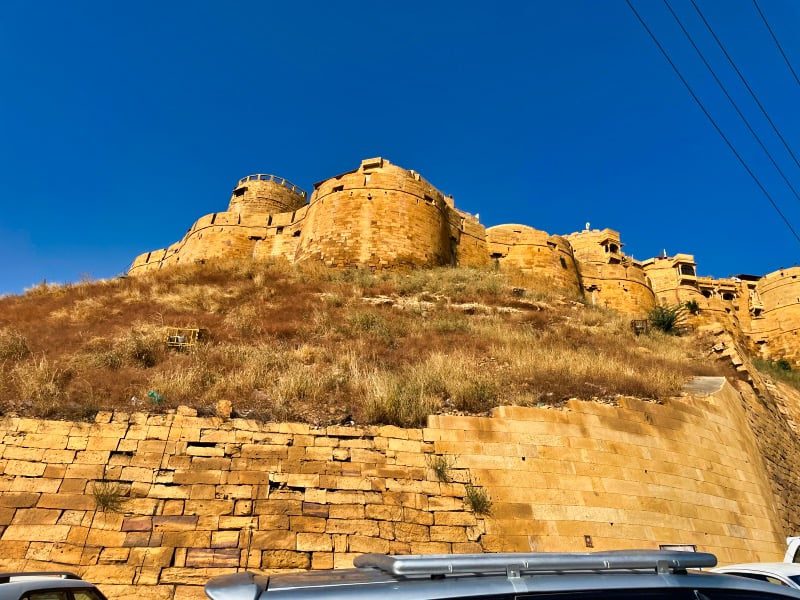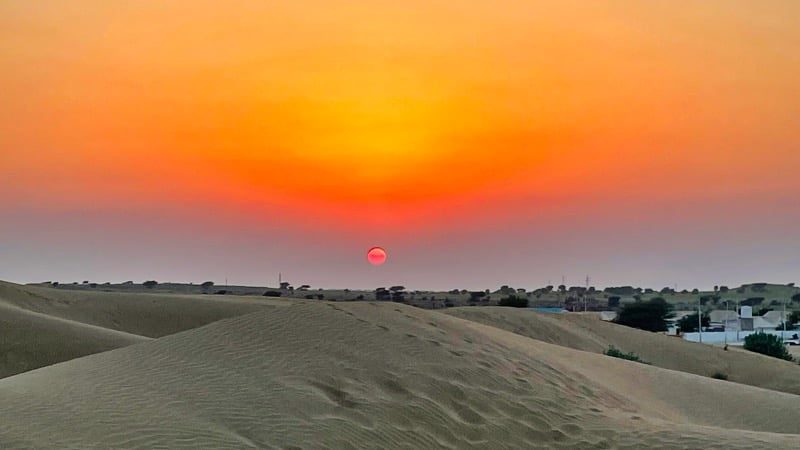Jaisalmer, a remarkable city in Rajasthan, India, known for its golden beauty and desert charm. You might wonder why such a place was built in the middle of the desert.
Jaisalmer was strategically built several centuries ago in the desert to serve as a stronghold by Maharawal Jaisal. Its elevated position on a hill offered an excellent vantage point to spot any approaching enemies.

Jaisalmer is often referred to as the “Golden City.” This moniker is attributed to the city’s golden sandstone architecture that seems to glow in the warm desert sunlight. This epithet reflects the enchanting golden ambiance that envelops Jaisalmer, making it a captivating destination in the heart of the Thar Desert.
The city’s stunning golden architecture, including the famous Golden Fort, was constructed using the abundant sandstone found in the area, which glows like gold in the sunlight lending the city its distinctive charm. The Jaisalmer Fort, was built approximately 800 years ago in the 12th century. It was founded by Maharawal Jaisal, a Rajput ruler, who established the fort as a strategic stronghold in the Thar Desert of Rajasthan, India. Over the centuries, the fort has stood as a testament to the rich history and architectural brilliance of the region.

Despite its seemingly desolate location, Jaisalmer thrived as a bustling trading hub. Merchants from distant lands would journey here, bringing exotic goods and cultural influences. The city’s prosperity grew along with the trade routes that passed through its gates.
Today, Jaisalmer continues to captivate visitors with its enchanting atmosphere. From exploring the winding lanes of the fort to enjoying camel rides in the vast desert dunes, there’s always something exciting to experience. Jaisalmer’s existence in this arid land is a testament to the resilience and ingenuity of its people, who have created a vibrant oasis amidst the desert sands.
The Golden Fort or Sonar Quila
Jaisalmer Fort, also known as Sonar Quila or the Golden Fort. It is located in the city of Jaisalmer, Rajasthan, India. This imposing fortress stands proudly on a hilltop and is a UNESCO World Heritage Site.
Jaisalmer Fort is unique because it is not just a historical monument but also a living fort with a vibrant community residing within its walls for many generations. It is one of the few fully inhabited forts in the world. Within its massive sandstone walls, you’ll find a maze of narrow streets, bustling markets, traditional houses, and numerous shops selling handicrafts, textiles, and jewelry.
The fort was built in the 12th century by Rajput ruler Maharawal Jaisal and served as a strategic stronghold on the ancient trade route between India and Central Asia. Its golden hue, which blends harmoniously with the surrounding desert landscape, has earned it the name “Golden Fort.” The fort’s walls, made of locally sourced yellow sandstone, seem to glow like gold when bathed in sunlight.
The architecture of Jaisalmer Fort is a splendid example of Rajputana style, characterized by intricately carved jharokhas (balconies), ornate facades, and impressive gateways. It houses several Jain temples, including the famous Jain temple dedicated to Lord Parshvanath.
Living within the fort walls, the families have preserved their rich cultural heritage and traditional way of life. Their homes have been passed down through generations, and they continue to maintain the customs and traditions of their ancestors. The fort community has its own schools, shops, and basic amenities, making it a self-sustained microcosm within the larger city.
A visit to Jaisalmer Fort offers a glimpse into a bygone era, where history and contemporary life coexist. Exploring its narrow lanes, interacting with the locals, and witnessing the stunning views of the city and Thar Desert from the fort’s ramparts make for an enchanting experience.
Jaisalmer Fort stands as a testament to the architectural brilliance of the past and the resilience of the present, preserving the cultural fabric of Rajasthan in its timeless embrace.
See more Places in Rajasthan









